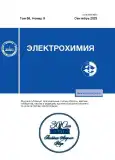Vol 59, No 9 (2023)
Modeling of Formation of Metal Microstructures by Local Electrodeposition on Conducting Substrate
Abstract
The formation of metal microstructures on metal substrates is theoretically analyzed by the example of local silver electrodeposition using the numerical simulation of interrelated electrochemical and homogeneous chemical reactions.
The distributions of the concentrations of the participants in the reactions and the current density of silver ion reduction are calculated for various concentrations of solution components and interelectrode distances. The degree of localization of metal deposition depends on the distribution of the concentrations of electroactive silver cations and the nonelectroactive complex of this metal near the anode. The conditions for reaching the maximum rate of local silver electrodeposition are determined.
 483-494
483-494


FEATURES OF THE ELECTROCHEMICAL BEHAVIOR OF CHLOROPHENOXY SUBSTITUTED COBALT AND COPPER PHTHALOCYANINATES IN NON-AQUEOUS MEDIA
Abstract
The electrochemical behavior of tetra-4-[4-(2,4,5-trichlorophenoxy)]phthalocyaninates of cobalt(II) (CoPc) and copper(II) (CuPc) in N,N-dimethylformamide 0.1 M nBu4NBF4 was studied by cyclic voltammetry. It has been experimentally established that both metal complexes are capable of irreversible reduction. In the reverse part of the CV curve for CoPc, an oxidation peak is observed, which is absent during anodic scanning, and corresponds to the cathodic reaction product. The metal complexes themselves do not oxidize under the conditions.
 495-500
495-500


Analysis of Effect of Concentration Dependence of Exchange Current on the Metal Electrodeposition into Template Nanopores
Abstract
Metal electrodeposition into the nanopores of template of porous anodic alumina type under the conditions of mixed kinetics is studied theoretically using analytical and numerical methods. Two main stages of the process are studied: the non-steady-state formation of diffusion layer in the template pores and much longer process of pore filling with metal. The effect of nonlinearity of the concentration dependence of exchange current density of metal electrodeposition on the current density of the diffusion layer formation and pore filling with metal is studied.
 501-509
501-509


ELECTROCHEMICAL PARAMETERS OF MICROBIAL FUEL CELLS BASED ON THE MICROCOCCUS LUTEUS STRAIN, NEW ION-EXCHANGE MEMBRANES AND VARIOUS SUGARS
Abstract
We studied the physicochemical and electrochemical characteristics of microbial fuel cells (MFCs) with a new proton-exchange membrane. It was synthesized on the basis of zeolite-doped polyvinyl alcohol cross-linked with sulfosuccinic acid (PVA-SSA-BEA). An MF-4SK industrial membrane (Plastpolymer, Russia) was used as a comparative sample. Various sugars were added as substrates (glucose, arabinose, galactose, xylose). The role of the bioagent was performed by the strain Micrococcus luteus 1-i. MFCs with PVA-SSA-BEA and MF-4SK membranes showed rather close electrochemical characteristics. A higher electricity output was performed with the addition of glucose, galactose, the lowest - with the use of xylose. The data obtained indicate that the proposed PVA-SSA-BEA membrane is promising for use as an alternative to proton-exchange membranes widely used in fuel cell technology.
 510-516
510-516


CARBON NANOPAPER PRODUCED FROM CARBON NANOTUBES/RESORCINOL-FORMALDEHYDE XEROGEL NANOCOMPOSITE FOR ELECTROCHEMICAL SUPERCAPASITORS
Abstract
The nanocomposite of resorcinol-formaldehyde xerogel (RF-xerogel) and carbon nanotubes after carbonation at 800 °С was obtained in the form of composite carbon nanopaper (CCNP) with a thickness of 100-300 microns, a density from 0.1 g/cm2 to 0.5 g/cm2 and an electronic conductivity of more than 10 S/cm. According to the low temperature nitrogen adsorption data, the microporous structure of the nanopaper is formed by carbonized RF-xerogel, and the mesoporous structure is formed by the nanotube framework. The specific surface area of the nanopaper calculated by the method of nonlocal density function theory (NLDFT) exceeds 600 m2/g. The main contribution to the specific surface area of CCNP is made by pores with a width of ~ 0.7 nm, therefore, electrodes for a supercapacitor made of such paper are quite effective only in aqueous solutions of H2SO4 and KOH with small sizes of solvated ions. A technique for nanopaper activation with potassium hydroxide has been developed for the use of CCNP with organic electrolytes. The maximum specific surface area (NLDFT method) of activated CCNP reaches 1182 m2/g with a loss of carbon xerogel mass of ~ 25%. At the same time, the pore surface area of more than 1 nm width increases from 350 m2/g in CCNP to 685 m2/g in activated CCNP. Nanopaper has mechanical strength, pretty cheap and convenient for use in supercapacitors.
 517-529
517-529


Diamond Compact Electrodes with Increased Electroactivity: Anodic Oxidation of Ethylenediaminetetraacetic Acid
Abstract
The diamond electrodes-compacts with extreme high boron-doping level, added with platinum, were prepared at a pressure of 8―9 GPa and temperature ~2500 К from growth mixtures В–С, Pt–C, and Pt–C–B. They are highly electroactive in the reaction of ethylenediaminetetraacetic acid electrooxidation. The oxidation current is a linear function of the ethylenediaminetetraacetic acid concentration over the 0.001–0.05 g-equ/L range. This system can be basic to an electroanalytical method for the ethylenediaminetetraacetic acid determination.
 530-535
530-535


ELECTRODEPOSITION SILVER(I) SELENIDE FROM AQUEUOS THIOCYANATE SOLUTIONS
Abstract
Electrodeposition of silver(I) selenide possessing pronounced thermoelectric properties was carried out from aqueous solutions containing thiocyanate complexes of silver(I) and Se (IV) compounds at pH 4.7. Ag2Se is formed at cathode potentials more negative than –0.9 V (s.h.e.). The obtained coatings were characterized by scanning electron microscopy (SEM), X-ray photoelectron spectroscopy (XPS), X-ray phase analysis (XPA), and atomic force microscopy (AFM). The stoichiometry of the cathode deposit is close to Ag2Se. Diffraction studies have shown that an orthorhombic modification of silver(I) selenide is formed under electrodeposition conditions. Cathode deposits have a columnar nanostructure.
 536-542
536-542











